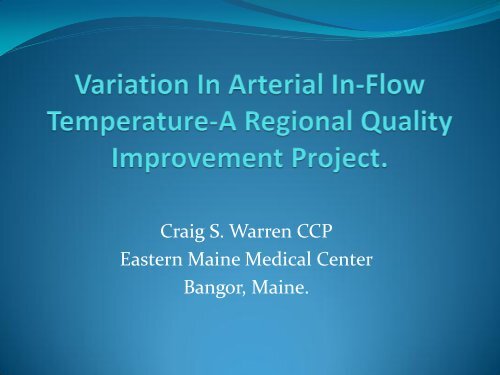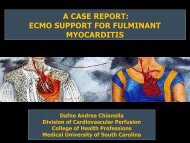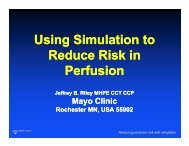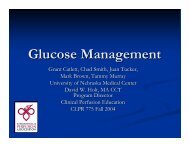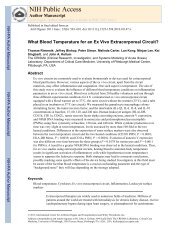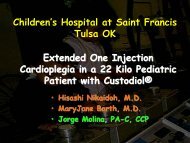PowerPoint Presentation (PDF) - Perfusion.com
PowerPoint Presentation (PDF) - Perfusion.com
PowerPoint Presentation (PDF) - Perfusion.com
You also want an ePaper? Increase the reach of your titles
YUMPU automatically turns print PDFs into web optimized ePapers that Google loves.
Craig S. Warren CCP<br />
Eastern Maine Medical Center<br />
Bangor, Maine.
We have no material, financial or other<br />
relationship with any Healthcare related<br />
business whose products or services that were<br />
used in this project.
Avoid Hyperthermia<br />
S<br />
(Class IIa, Level B)<br />
S<br />
JTCVS 2006<br />
Oxygenator Temperature ports – Check for accuracy/ Calibrate<br />
(Shann, JTCVS 2006)
Guideline<br />
Limiting Arterial line Temperature to<br />
37 Degrees Celsius may be useful for<br />
avoiding cerebral hyperthermia. (Class<br />
II A, Level B)
The temperature from the oxygenator arterial outlet<br />
temperature port can underestimate the actual temperature<br />
of the perfusate.<br />
In Vitro Validation of the Affinity<br />
NT Oxygenator Arterial Outlet<br />
Temperatures<br />
JECT, 2005<br />
Kieron C. Potger, BSc, CCP; Darryl McMillan,<br />
CCP<br />
Department of Anaesthesia and Pain<br />
Management, <strong>Perfusion</strong> and Autotransfusion<br />
Unit, Royal North Shore Hospital,<br />
Sydney, Australia<br />
Presented at the 20th Annual Scientific Meeting<br />
of the Australasian Society of Cardio-Vascular<br />
<strong>Perfusion</strong>ists,<br />
“ Coupled temp probes should be checked for accuracy and<br />
calibrated”
<strong>Perfusion</strong>ists<br />
NNE PERFUSION GROUP
<strong>Perfusion</strong> Registry<br />
Form
Diodato, JECT 2008<br />
Ject 2008<br />
Gaps exist between practice and published re<strong>com</strong>mendations<br />
WIDE VARIATION IN PRACTICE EXISTS
1<br />
Regional Quality<br />
Improvement<br />
Project<br />
3<br />
2<br />
4<br />
CABG Surgery Patients Jan 2006- Dec 2008<br />
Four NNE Centers
•Validation and calibration of coupled temp ports<br />
•Lowering target temperature for separation from CPB<br />
•Resetting Heater Cooler thermostats<br />
•Employment of audible temperature alarms<br />
•Reducing the rate of re-warming<br />
•Purchase of new heater-coolers
Fluke-Precision<br />
biomedical grade<br />
temperature analyzer
Thermistor Probe
1. A prime solution was circulated at 4 LPM in a<br />
closed-loop circuit.<br />
3. Steady state measurements were made at 30, 38 and<br />
40 degrees centigrade on the heater-cooler.<br />
4. All centers utilized a Sorin S3 pump (Heart-lung<br />
machine), which was used to monitor and display<br />
temperature.
Temperature port vs. Thermistor probe<br />
Center 1: 0.05 degrees higher<br />
Center 2: 0.5 degrees lower<br />
Center 3: 1 degree lower<br />
Center 4: 0.5 degrees lower
Four centers within NNE<br />
Submitted data concerning highest arterial blood<br />
temperatures for CABG procedures between 2006-<br />
2008 and analyzed data to thresholds of 37.0 and<br />
37.5 degrees C.
Results<br />
Data for 3,318 procedures<br />
1,180 before interventions, 1,438 after.<br />
Pre-Interventions VS Post-Interventions<br />
88 % temps ≥ 37⁰ 74% temps ≥ 37⁰<br />
48 % temps ≥ 37.5⁰ 23 % temps ≥ 37.5⁰
Percent of Inflow Temperature>=37: Pre and Post Intervention<br />
100<br />
90<br />
80<br />
70<br />
60<br />
50<br />
40<br />
30<br />
20<br />
p
Degrees Centigrade<br />
H i g h e s t b l o o d t e m p e r a t u r e o n C P B<br />
( l a s t 200 b y p a s s p r o c e d u r e s f o r e a c h c e n t e r )<br />
3 8<br />
3 7 . 5<br />
3 7<br />
3 6 . 5<br />
3 6<br />
1 2 3 4<br />
e x c l u d e s o u t s i d e v a l u e s<br />
C e n t e r
Degrees Centigrade<br />
H i g h e s t b l o o d t e m p e r a t u r e o n C P B<br />
3 9<br />
3 8<br />
3 7<br />
3 6<br />
2009<br />
2008<br />
2007<br />
2006<br />
2005<br />
2009<br />
2008<br />
2007<br />
2006<br />
2005<br />
2009<br />
2008<br />
2007<br />
2006<br />
2005<br />
2009<br />
2008<br />
2007<br />
2006<br />
2005<br />
1 2 3 4<br />
C e n t e r<br />
e x c l u d e s o u t s i d e v a l u e s
Table II. Univariate Associations Between Patient Characteristic and Disease Variables, and Risk of Hypethermia<br />
Variable % of Subjects % Hyperthermia p-value Variable % of Subjects % Hyperthermia p-value<br />
Patients (number) 3,318 82.0 Patients (number) 3,318 82.0<br />
Age(years)<br />
Number of Diseased Vessels<br />
75 19.5 78.1 3 43.8 84.1<br />
0.45 ptrend
In Summary<br />
Our Quality Improvement Project<br />
•Improved performance around the published<br />
guideline.<br />
•Identified opportunities to improve temperature<br />
management.<br />
•Most patients were not exposed to elevated arterial<br />
line temperatures. (37⁰C or 37.5⁰C)
Quality Improvement Project<br />
and<br />
Evidence Based Medicine<br />
Why worry about Hyperthermia
Cerebral Injury after CPBypass<br />
Predominant <strong>com</strong>orbidity<br />
1% to 5% CABG stroke incidence<br />
30-60% CABG neurocognitive deficit
Hypothermia<br />
• Reduces cellular metabolism , improving tolerance<br />
to ischemia.<br />
• Decreases energy consumption (approx 7%/ deg C).<br />
• Increases tolerance to reduced flow and oxygen<br />
delivery.<br />
• Minimizes acidosis that ac<strong>com</strong>panies ischemia.
Hypothermia--Disadvantage<br />
Potential for cerebral HYPERthermia during<br />
rewarming<br />
High arterial in-flow temperatures<br />
Carotid artery proximity to<br />
cannulation site
Actual brain<br />
temp during<br />
rewarming may<br />
exceed core temp<br />
by up to 3⁰C<br />
39-40⁰
Physiologic effects of Hyperthermia<br />
• Accentuates release of neurotransmitters<br />
(glutamate)<br />
• Increases oxygen free radical production<br />
• Increases blood-brain barrier permeability<br />
• Increases intracellular acidosis<br />
• Delays neuronal metabolic recovery
Temperature Measurement Sites<br />
Nasopharyngeal<br />
Esophageal<br />
Bladder<br />
Rectal<br />
Blood (PA catheter)<br />
Arterial blood in-flow<br />
(Jugular bulb venous temperature)
Nussmeier et al., from Texas Heart institute.<br />
Nasopharyngeal, Esophageal, Bladder and Rectal<br />
sites underestimated Jugular bulb temperature.<br />
Cerebral HYPERthermia may result during rewarming.<br />
Nasopharyngeal and Esophageal temperatures can underestimate<br />
jugular bulb temperature by as much as 2⁰ C.<br />
ONLY the temperature of the BLOOD EXITING THE<br />
OXYGENATOR provides an accurate measure of jugular<br />
temperature during rewarming.<br />
Nussmeier, S. Li, A. G. Strickler, E. Dragan, R.K. Korkki, J.R. Cooper, Jr. Temperature measurement during Cardiopulmonary<br />
Bypass. Anesth Analg. 2002;93,SCA1-SCA112
Grocott et al, Duke University<br />
Patients rewarmed at an average of .49<br />
⁰C/min. fared better than those rewarmed<br />
at .56⁰ C/min (typical rate).<br />
Grocott HP, Mackensen GB, Grigore AM, Mathew J, Reves<br />
JG, Philips-ButeB, et at. Postoperative hyperthermia is<br />
associated with cognitive dysfunction after coronary artery<br />
bypass graft surgery. Stroke, 2002;33:537-41.
Grigore et al, from Duke University<br />
Patients were warmed at a slower rate, maintaining no<br />
more than 2⁰ difference between NP and Arterial blood<br />
temperatures.<br />
Greater neuropsychologic dysfunction in patients<br />
randomized to a faster, rather than slower, rewarming<br />
rate .<br />
Grigore AM, Grocott HP, Mathew JP, Phillips-Bute B, Stanley TO,<br />
Butler A, et al. The rewarming rate and increased peak temperature<br />
alter neurocognitive out<strong>com</strong>e after cardiac surgery. Anesth Analg.<br />
2002;94:4-10.
Slower Rates of Rewarming:<br />
•Improves the ratio of O2 supply vs demand in the<br />
Brain.<br />
•Less chance of cerebral emboli (gaseous)<br />
•Less Hyperthermia/Less tissue injury
Neurocognitive Function in Patients<br />
Undergoing Coronary Artery Bypass Graft<br />
Surgery With Cardiopulmonary Bypass: The<br />
Effect of Two Different Rewarming Strategies.<br />
Bikash Sahu, Sandeep Chauhan, et al. Cardiothoracic and Vascular<br />
Anesthesia vol 23,# 1, 2009<br />
Randomized trial of 80 adult patients<br />
Group A-40 patients, Group B-40 patients<br />
Primary isolated CABG’S cooled to 30⁰C<br />
Group A warmed to 37⁰ NP vs Group B warmed to 33⁰ NP.
Results:<br />
Significant deterioration in neurocognitive function in<br />
patients warmed to 37⁰ C.<br />
Increased levels of S100B in patients warmed to 37⁰<br />
<strong>com</strong>pared to patients warmed to 33⁰.<br />
Time to extubation was longer in patients warmed to 33⁰.<br />
There were no significant differences in:<br />
Post-op blood loss<br />
Blood product, inotrope, vasodilator, or pacing<br />
requirements in patients warmed to 33⁰


